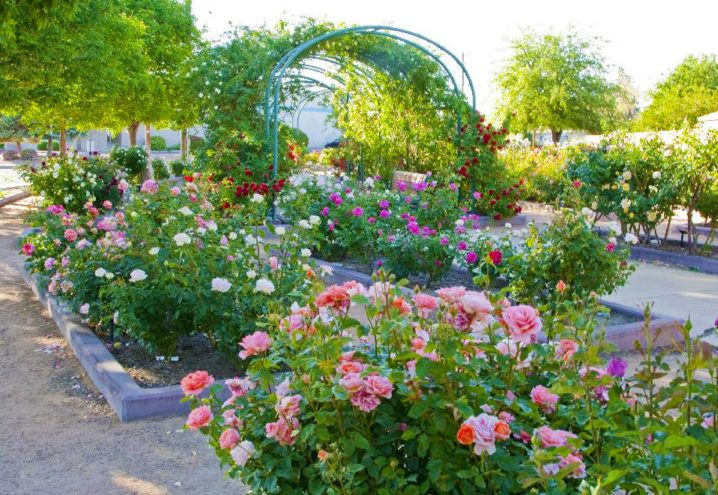
Across the globe, species of roses have originated in high deserts. In New Mexico and Utah, our native rose is Rosa Woodsii. It grows at 7,700 to 10,000 feet above sea level, has small pink flowers, many thorns, and can grow to eight feet. It’s considered a species rose meaning it is an original variety from which others can be bred on its native root stock.
Roses which are bred, or hybridized, on native roots specific for an area have increased vigor, more blooms, and live longer. They also only require moderate water in spring and summer and less in fall and winter.
Hybridization is done by taking pollen from one species and placing it on the female part of the other, making sure that none of the pollen of the host species also self-pollinates. When the small red or orange rose hips (seed pods) develop in the fall on the host plant, their seeds ideally will have the desired characteristics of the donor rose but the root vigor of the host. However, it may take thousands of tries to get the desired pure new rose. An example is the Don Juan rose which only reached market as a cultivated rose after 10 year of testing. Cultivated roses are patented and there are stiff fines for using its seeds or cuttings to breed a new rose.
Although Rosa Woodsii is our native species, it is not used for root stock, as others do better at this altitude. Most roses in this area are grafted on Dr. Huey root stock which is used for both tea and “old roses.” The latter means that the particular species was around before 1867 when tea roses were developed. Tea roses are grafted on root stock and bred for their long sturdy stem.

Classes of roses are based on their height. For example, mini (1-2 feet), shrub (3-4 feet), floribunda (5-6 feet), hybrid tea (6-7 feet) and the climbers which grow to 15 feet. The shrub roses are the ones most cultivated in this region, since their compact growth pattern allows leaves to provide shade for the plant. They are easier to care for and drop their own petals so you do not need to dead head them.
There are also other species, hybridized on different root stocks, which do well in a dry climate. The Lady Banks rose is easy to recognize with its cascades of small yellow or white flowers in spring. One of these in Tombstone, Arizona, has a trunk over three feet in diameter! The Pat Austin is a very fragrant rose, copper colored, and with lots of petals. It is a repeat flowering rose and was hybridized in 1995 in England. The Austrian Cooper is another hardy favorite in the mid Rio Grande.
While our desert soil needs lots of organic material (a 1:1 ratio of compost and soil) to support the life of roses, high desert roses do not suffer as much from the mildew or black spot fungi as do species growing in humid areas. They also do not have to contend with the Japanese beetle. Roses need sun, good drainage to avoid “wet feet,” and some iron added to the soil.
Some local places to find roses and more information include the BioPark’s High Desert Rose Garden. This garden has many species, including climbing, shrub and floribunda roses in a wide variety of fragrances and colors. Periodic rose shows at the adjacent pavilion are a good place to further your education.
The Rose Society has over a thousand varieties in its Hoffman town garden. The volunteers, called consulting rosarians, can help you with questions or problems you are having.
Brian, the rosarian at Rehms nursery has a greenhouse where over 2,000 varieties are grown annually in New Mexican soil. He grows both grafted as well as those on their own root stock.

